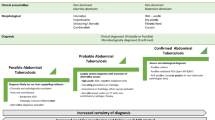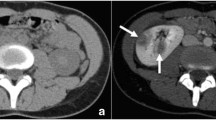Abstract
The purpose of this study was to describe of peritoneal manifestations of parasitic infection at CT. A broad spectrum of CT findings can be seen in the peritoneal cavity, including a varying degree of omental or mesenteric infiltration, single or multiple peritoneal mass or nodule, and peritoneal thickening or stranding. Recognition of these findings are crucial for establish an early diagnosis and helps avoid unnecessary surgery.








Similar content being viewed by others
References
Reeder M, Palmer P (1989) Infection and infestations. In: Margulis AR, Burhenne HJ, (eds). Alimentary tract radiology, 4th edn. St.Louis: Mosby, pp 1524–1525
Cho SY, Bae JH, Seo BS, et al. (1975) Some aspects of human sparganosis in Korea. Korean J Parasitol 13:60–77
Rangheard AS, N’Senda P, Dahan H, et al. (1999) Peritoneal location of fascioliasis mimicking a peritoneal carcinomatosis. J Comput Assist Tomogr 23:699–700
Rha SE, Ha HK, Kim JG, et al. (1999) CT features of intraperitoneal manifestations of parasitic infestation. AJR 172:1289–1292
Singcharoen T, Rawd-Aree P, Baddeley H (1988) Computed tomography findings in disseminated paragonimiasis. Br J Radiol 61:83–86
Cespedes M, Saez A, Rodriguez I, et al. (2000) Chronic anisakiasis presenting as a mesenteric mass. Abdom Imaging 25:548–550
Masui N, Fujima N, Hasegawa T, et al. (2006) Small bowel strangulation caused by parasitic peritoneal strand. Pathol Int 2006;56:345–349
Yobogawa M (1965) Paragonimus and paragonimiasis. Adv Parasitol 3:99–158
Karavias DD, Vagianos CE, Kakkos SK, et al. (1996) Peritoneal echinococcosis. World J Surg 20:337–340
Pedrosa I, Saiz A, Arrazola J, et al. (2000) Hydatid disease: radiologic and pathologic features and complications. Radiographics 20:795–817
Lee JH, Yu JS, Park MS, et al. (2005) Abdominal sparganosis presenting as an abscess with fistulous communication to the bowel. AJR 185:1084–1085
Han JK, Choi BI, Cho JM, et al. (1993) Radiological findings of human fascioliasis. Abdom Imaging 18:261–264
Kim H, Kim SI, Cho SY (1984) Serologic diagnosis of human sparganosis by means of micro-ELISA. Korean J Parasitol 22:222–228
Author information
Authors and Affiliations
Corresponding author
Rights and permissions
About this article
Cite this article
Kim, S.Y., Ha, H.K. Peritoneal manifestations of parasitic infection. Abdom Imaging 33, 172–176 (2008). https://doi.org/10.1007/s00261-007-9321-2
Published:
Issue Date:
DOI: https://doi.org/10.1007/s00261-007-9321-2




